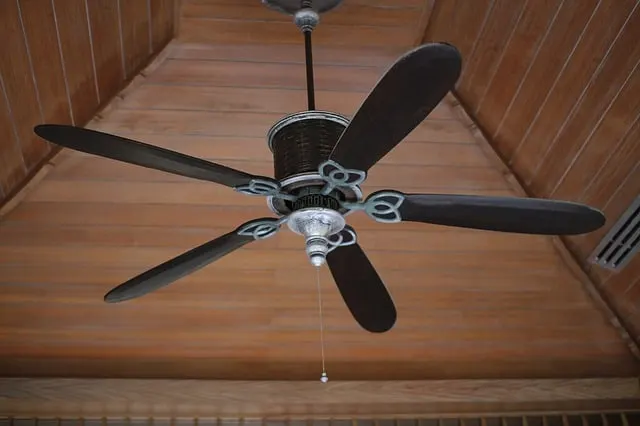
Have you been wondering what the best way to accessorize a room might be? Has your partner been getting on your case about installing a ceiling fan in one of your bedrooms or the den? As warmer weather approaches, it may be time to consider one of the simplest, most effective home improvement projects around, installing a new ceiling fan.
Ceiling fans are practical, add value to your home, and can readily enhance the overall look of the space they occupy. If you are looking to install a new ceiling fan or two, it may seem challenging to decide what type of fan to get. But do not let the myriad options stop you.
Remember each fan type has its advantages and disadvantages, and with a bit of research and minimal effort, you can be enjoying your new ceiling fan in no time.
Here are five of our favorite types of ceiling fans that work well in any part of your home, including the pros and cons of each. Check it out below:
Standard Fan with Or Without Lights
Sometimes, nothing beats the classics.
If you are interested in getting a ceiling fan for an average-sized room, why not get a standard ceiling fan? They can be purchased with or without lights and contain 3, 4, or 5 blades. While there are a variety of styles available, the two most common are rustic—which provides a touch of classic architectural flair—and modern, which gives a more streamlined, minimalist design with a modern finish.
The standard type of ceiling fan mounts to a flat, vaulted, or sloped ceiling using a downrod. They are intended for rooms with ceilings higher than eight feet. Downrods are surprisingly useful. They help the fan circulate more air, provide much better stability, and have remarkable wobble-reduction potential.
While large downrods are available, most measure around 2-6″, with shorter downrods being recommended for standard ceilings. Lighting options—including LED and standard lights—are available for most standard fans, but light-free options are also available.
If you get a fan without lights and decide you want them later on, it’s easy enough to go the DIY route and install some yourself with a kit.
Remote-Controlled Ceiling Fans
People love convenience, and there is nothing more convenient than controlling a ceiling fan without the need to get up from your comfortable seat.
They work the same way as TV remotes do, for the most part. A ceiling fan remote has a transmitter inside its casing. The transmitter transmits the signal to a special receiver in the ceiling fan.
The fan, in turn, operates based on the desired function of the user. Most remote controls operate via RF frequencies, independently of most other devices. The remote can control the fan’s speed, the lights, and switch it on or off.
The only real caveat of remote controls is how easily they can be lost and the fact that they need batteries to operate. Sometimes, the ceiling may require a special mount as well, so be sure to know what your installation will require before deciding to go in this direction for your next ceiling fan.
Low Profile Ceiling Fans
Let’s say you have a smaller room or space with a lower ceiling that needs better airflow.
A low-profile ceiling fan might be a great option. Also known as “hugger” style mounts, these ceiling fans essentially hug the ceiling, which consequently circulate air more efficiently in smaller spaces.
These fans do not have downrods and are intended for ceilings lower than eight feet high. The best hugger ceiling fans come in various styles including Modern (sleek, minimalist), Transitional (transitional features, subtlety, and smooth lines), Industrial (heavy-duty construction, an edgy appearance), and Rustic (wooden blades, organic style).
Outdoor Ceiling Fans
While indoor fans are a great investment for the home, what about an outdoor fan? Outdoor fans are ideal for patios, porches, garages, sunrooms, and gazebos (just to name a few).
They can be used in any outdoor space that is not exposed to direct moisture. These fans can provide an additional cooling element to some exterior spaces. Like indoor fans, they come in a variety of unique styles, designs, and finishes.
Choosing a fan depends on your space’s layout and what the weather is typically like around your home. Outdoor fans come with different ratings for the spaces in which they will be installed. The ratings are damp-rated, salt-rated, and wet-rated and ultimately depend on the space in which the fan will be installed.
Connected Fans
Some fans have wall switches. Others might use remote controls.
Then there is the classic pull chain. But the true final frontier of ceiling fan operation is smart, wireless control. This is where functionality meets technology. Using Wi-fi and your smartphone to control a ceiling fan is convenient and easier than you may expect.
You can install a smart switch or purchase a fan with wi-fi-connected technology already pre-installed.
Some fans come with proprietary technology that integrates them to be used with Alexa, Google Home, and Homekit. When shopping for smart fans, be sure to go with a reputable company and ensure the fan will work with your device. Then it is simply a matter of diving into the future and enjoying an awesome smart ceiling fan for years to come.
- Sagittarius Man & Gemini Woman Love and Sex Compatibility - January 31, 2024
- Taurus Ascendant Rising Personality Traits in Men (Guide) - January 31, 2024
- How to Seduce and Attract a Sagittarius Man (Seduction Tips) - January 31, 2024
